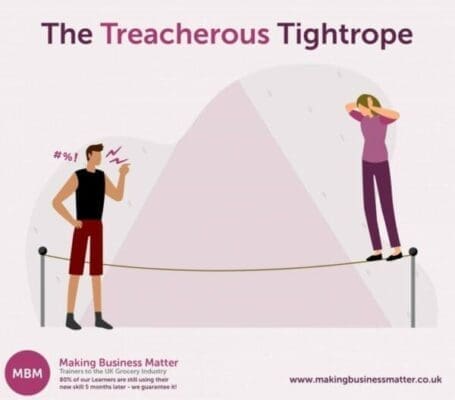Feel Like You’re Doomed to Fail?
When I was 15, my girlfriend told me that I needed to be more romantic. She’d just watched Dirty Dancing and not so secretly had a crush on Patrick Swayze. This was my first introduction to what I have named “the treacherous tightrope.” She had sown that seed, and I had agreed.
Over the coming weeks, I tried to be more romantic without really knowing what that meant beyond something to do with dancing, watermelons and wearing a tight black vest. I’d watched the film for clues. She kept giving me what I thought were pointers: “You need to bring me flowers.” “No, not those ones.” I just kept getting it wrong, and she seemed to be helping me to get it right. Six weeks later she called me to tell me that it just wasn’t working. I was gutted.
Recently I realized that over the following 40 years, that situation was not the only time something like that had occurred. Here’s another example:
As a buyer for a U.K. supermarket during the ’90s, I noticed many of my fellow buyers were putting their suppliers on treacherous tightropes. The buyers had supply bases that they often wanted to shake up by bringing in a new supplier, which meant losing a current supplier. To achieve this, the buyer would either set the current supplier very tough margin targets to achieve or set a project to understand their consumers, which would cost a lot of money, or run an e-auction. Each time, the supplier would fail and the buyer would achieve their desired outcome.
Understanding The Treacherous Tightrope
The treacherous tightrope is a model that helps us to understand when we are doomed to fail. It describes situations where we spend a lot of energy to just arrive at the inevitable outcome: failure. The model consists of three parts.

Work to Understand the Root Issue
Breaking from the treacherous tightrope is hard, and recognising when we are about to set one or walk one is the key. It is better to stop the situation before it starts than try to stop it after. As the tormentor, we need to face up to the fact that we are typically creating a situation because of one of three reasons:
1. We cannot make a decision.
2. We cannot articulate that decision.
3. We don’t want to share that decision.
Yes, it might feel good to watch someone attempt to fix the situation and even twang the tightrope as they do, but ultimately you will spend a lot of energy just to prove yourself right and that they were wrong. It is better to lead and set an example as a leader by adopting honest, open and direct communication. Leaders don’t have to be superheroes, they can be normal people like you and I, trying to be a better person today than we were yesterday.
Recognise the Situation and Ask Questions
When in the tormented position, like in any situation where you want to change, recognising what is happening is the very first step. Work to recognize when you are about to step into one of these situations, and give the tormentor every opportunity to share. With a soft and casually curious tone, ask questions like, “What could we do to improve?” or “What do you need to make a change?” or “What’s driving these changes?” Your questions should be open and inquisitive.
Make it easy for the other person to say no, to share the decision, to say what is hard. It’s better to hear the answer upfront than to spend what could be months changing a project, hiring new staff or trying to do the impossible. Only to fail and feel that you were to blame.
Sticky Learning ® is 7 times more effective than 1-day training courses. Plus, you will get a Chain of Evidence proving your Return on Investment. Discover soft skills training that changes behaviours long term.

Be Honest, Open and Direct
If you are the tormentor, you are not leading by example, with honest, open and direct communication. You are playing a game and communicating to others that this is okay to do. Others may then follow your example. I’ve found it’s always better to share what is really happening than to go through all the effort of creating a situation for someone to fail.
In the example of the buyers and suppliers above, the more effective and more experienced buyers challenged their supply bases with the unique selling points of the new suppliers, which might have been unparalleled quality, service or price. And they agreed on a time frame to achieve these goals, making clear the consequences for each outcome.
In conclusion, this model can help us to realize when we are “flogging a dead horse,” as the saying goes. I see so much time, energy and money spent pursuing an inevitable failure, followed by people beating themselves up that they could have done better, more and quicker, when in fact what was meant to happen did.
My hope is that the treacherous tightrope becomes a phrase we can use to help recognise when our efforts are pointless. We live in a “be positive” world, or we try to, and tormentors often know this. Unfortunately, this means that we try when we are doomed to fail. I think it is better to put our energies into what could work. Rather than what won’t work because someone has already decided our fate.
Look out for any treacherous tightropes you are walking, might walk and those that you may set for others.
This article on being doomed to fail was written by Darren A. Smith for Forbes.




